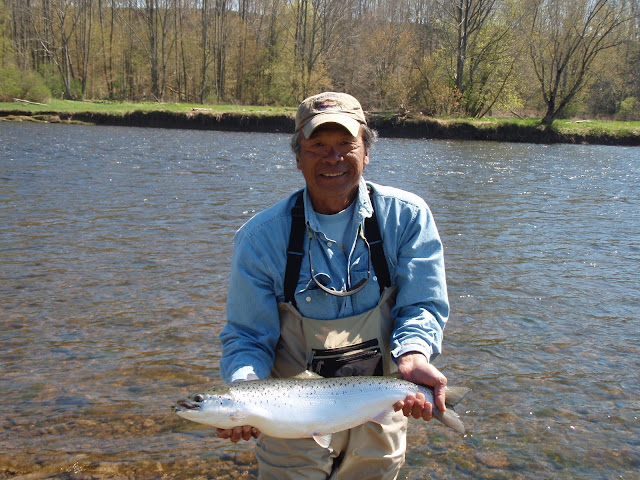By Spider Rybaak
 |
Local
fly-fishing guide Pat Miura (315-777-3570) holding a trophy landlocked Atlantic
salmon he took last spring from the
|
When you’re as pretty--and mildly wild-- as the
This year’s releases have mostly already taken place, and August was cancelled because of low water levels in the reservoir. So there’s only one more planned officially, the first weekend of September.
However, there’s always a chance we’ll get some heavy
rains this month; and if we do, the river will come up all by itself. If that
happens, grab a rubber tube, air mattress, kayak or anything that’ll float
while you’re in it, and a buddy--you wanna have two cars so you can leave one
at put-in and take-out—and launch on a whitewater thrill so mildly exciting,
you’re guaranteed to get wet.
No craft?...Not into
whitewater?...No sweat. There’s more to do during high water.
Take fishing for landlocked
Atlantic salmon, for instance. Indeed, the Salmon River is the best fast lane
in the U.S. for catching a
keeper trophy landlocked Atlantic . Our
Atlantic salmon are stocked by the NYS DEC. (Natural
strains of Atlantic salmon are ocean-running fish,
and are on the endangered species list.)
Known as the king of fish in
Europe because of its superb beauty, extraordinary leaping prowess, incredible
power and stamina, and ability to survive the spawning ordeal and do it a
second, even third time (it’s the only American salmon capable of spawning more
than once), pursuing this fabulous critter is one of the most worthy challenges
anglers face in freshwater.
Up until the 19th century, Lake Ontario
The feds and NYS Conservation Department (precursor to
today’s NYS Department of Environmental Conservation), spurred by the increased
environmental awareness spawned during the hippie era (the 1960s), decided to
restore the species into the tiniest Great
Lake
Late in the last century, the authorities stocked various
Lake Ontario Oswego County
Alewives, exotic forage that
entered the Great Lakes system through the Erie Canal ,
were waging biological warfare on the Atlantics and winning. Rich in
Thiaminaze, an enzyme that breaks down thiamine, a vitamin essential to salmon
reproduction, the salmon were eating themselves to impotence. The condition was
called the Cayuga Syndrome, after Cayuga Lake
where it was first fingered. Oh, the fish still went through all the moves--run
upstream, court, lay their eggs, fertilize them--but the offspring died before
they could get beyond the sac-fry stage. Mortality was total.
Finally figuring out what was
happening, the authorities lifted the ban on fishing the Little Sandy and got
used to the idea that the only way to maintain a token presence of the species
in Lake Ontario
Thousands of Atlantics have
been stocked annually over the past 20-something years. While these numbers are
tiny compared to the quantity of Pacific salmon stocked each year, the effort
gives anglers a chance at catching this highly desirable and coveted native New
Yorker.
The most warmwater tolerant salmon, a few Atlantics are
in the river all summer long. Periods of high water, like after a rain or
during whitewater releases draw fresh fish upstream. What’s more, the food rich
higher water often spurs a feeding binge.
So if you’re into fishy challenges, the Salmon
River offers one of the toughest in the fishing world.
But there’s more.
“For the past three years, 2009, 2010 and 2011, we’ve
netted as many as 48 naturally reproduced fingerlings in the river in any given
year,” claims Dr. James Johnson, ecologist and branch chief at the USGS’
Tunison Laboratory of Aquatic Science in Cortland ,
NY
There’s no shortage of theories. One even speculates the
round goby, an exotic species indigenous to the Black Sea ,
is the hero in this wonderful mystery.
I asked Dr. George Ketola, a
research physiologist at Tunison Laboratory, if the gobies could be helping the
salmon replenish the thiamine status in their eggs.
“That makes good sense,” the Dr. replies. “Gobies are
high in thiamine and with the availability of that food source before
spawning…if they have a month or so of exposure…it should make a difference.
And I suspect it helps their spawning.”
A little over three years is a long spell in salmon time,
long enough to reach trophyhood. The possibilities are the stuff of fantasy,
and if you participate right now, you could be one of the pioneers in this
developing fishery.
How do you tell a naturally
spawned fish from a stocky? Scott Prindle, fisheries biologist at the Cortland
By heading up to the Salmon River you’ll
experience the thrill of a naturally warmed rushing river, and the chance of
catching a naturally bred trophy landlocked Atlantic salmon, something that
ain’t been seen around these parts for over 100 years.
So c’mon up to the
Salmon River ; we'll keep the stream up for ya...for
a little while, anyway.
 |
| Fran Verdoliva releasing a nice landlocked Atlantic salmon he took in the summer of 2010. |
 |
NY007 John Kendell showing a trophy he took from the
|

No comments:
Post a Comment